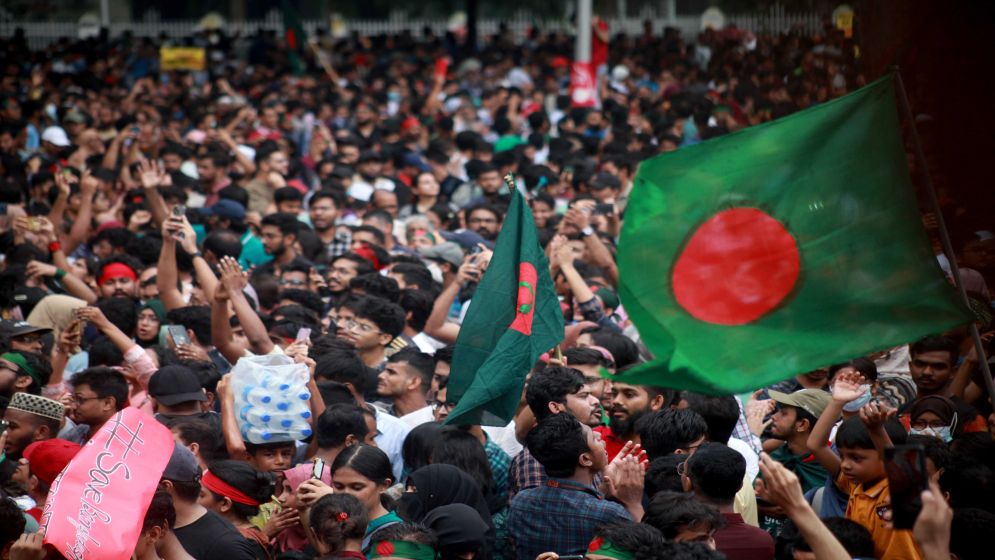Are we misinterpreting the spirit of the ‘Monsoon Revolution’ and overlooking its true credits?

Photo Credit: Nazmul Islam
Was the July Revolution a movement defined by a predetermined framework? Was it a grand narrative of a single ideology? The simple answer is: no.
I am explaining why…
Gradual brewing of an upsurge
This movement originated from protests against quota reforms. At the outset, few anticipated it would evolve into a single-point demand. The success of the July Revolution can be attributed to two main factors:
a. The lack of a specific 'revolutionary manifesto' or 'ideological master plan.' If such a document had existed, public involvement in the upheaval might not have been as widespread.
B. The widespread public outrage and the powerful surge of long-held aspirations.
For example, during the curfew, students and residents of Jatrabari defied any directives and remained on the streets. After the curfew was lifted, the organizers faced a dilemma between the 8-point and 9-point demands. Ultimately, the 9-point demands gained traction due to public support.
In fact, students and the public had already been advocating for the single-point demand a day before the organizers officially announced it. On August 2, the single-point demand was declared nationwide.
-66d4257aa68b0.jpg)
The overwhelming turnout from the Press Club to Shahid Minar that day effectively nullified the curfew situation at Dhaka University. This mass mobilization was a clear reflection of public aspirations, and the iconic image of the rickshaw puller saluting became a symbol of the revolution, captured during the protest march.
Consequently, this movement, which started as a fight against employment discrimination, did not follow a straightforward or pre-planned trajectory.
It was not the product of any single ideology or individual mind. Instead, it was driven by a new 'language and thought system' that has been evolving over the past decade in urban areas, especially on campuses and social media.
This movement was shaped by numerous ideas, forms, and extensive cultural and intellectual activism and interactions.
Thus, it is clear that no single individual was the primary force behind this movement; rather, it was the new 'language, thought, and symbolism' that played a crucial role in shaping it.
To view this revolution as the product of one person's ideas or personal thoughts would be to miss its core essence.
The 'post-ideological' political system that emerged under the Awami regime, focused mainly on rights-based politics, has been absorbed into public aspirations and evolved into this upheaval.
-66d425a76ca7d.jpg)
The unsung heroes
When no teacher at any university across the country, including Dhaka University, was willing to support the students, the Teacher Network stepped up.
On July 17, they organized the first program against campus closures under the banner of the 'Oppression-Resistant Teacher Society.'
After the curfew was lifted, and in the face of police, RAB, and army attacks, the Teacher Network once again took the lead, standing courageously with students at Dhaka University, Jahangirnagar University, Rajshahi University, and Chittagong University.
With the support of the Teacher Network, the student movement on campuses began to regain its momentum.
However, it now seems that the Teacher Network is being vilified. The same individuals who once supported their programs are now labeling the network as 'leftist,' 'Shahbaghi,' and other terms. Some are even calling for the dissolution of the Teacher Network!
The Teacher Network was undoubtedly a crucial player in this movement. The protest march to Shahid Minar was one of its pivotal events. Abdul Kader's 9-point demand played a key role in sustaining the movement during the curfew, countering the 8-point demand of Hasnat-Sarjes.
Additionally, the fact that the students and residents of Jatrabari continued their protests on the streets without any formal plan during the curfew is now being systematically disregarded.
Problematic narrative
This spontaneous, non-ideological movement is now being misrepresented with a pseudo-ideology, narrowing its scope and impact.
-66d425ccb3d6a.jpg)
Since August 5, the narrative of the upheaval has become entangled with government interests and power dynamics, even though the current government does not embody a revolutionary regime.
Its behavior and rhetoric, however, remain absolute and sovereign, similar to that of a revolutionary government, creating an uneasy situation.
This scenario represents a significant and immediate challenge in crafting a multidimensional and comprehensive narrative, spirit, and history for any upheaval.
A similar issue arose after the Liberation War, when the complex narrative and history of the war were overshadowed by the influence of Bangabandhu and the Awami League.
This led to the creation of a hollow and illusory consciousness detached from the war's realities—a strange ideology. Many field fighters became collaborators, while unfamiliar, unknown, and even pro-Pakistani figures took control. Those who sought to clarify the situation were silenced.
If Bangladesh faces such a crisis again, it could be problematic. Terms, projects, and agendas may be adopted in the name of this upheaval that actually contradict its true spirit.
The aspirations for universal democratic rights and a just, democratic state might be lost amid the implementation of new 'consciousness,' projects, and terminologies.
In the real political arena, there is a risk of a resurgence of fascism, events similar to 1/11, or even more dangerous developments.
May this not come to pass, and may a functional and creatively transformative democratic system be reestablished in Bangladesh.
—-
Tuhin
Khan is a member of the advisory council of Democratic Student Force.

